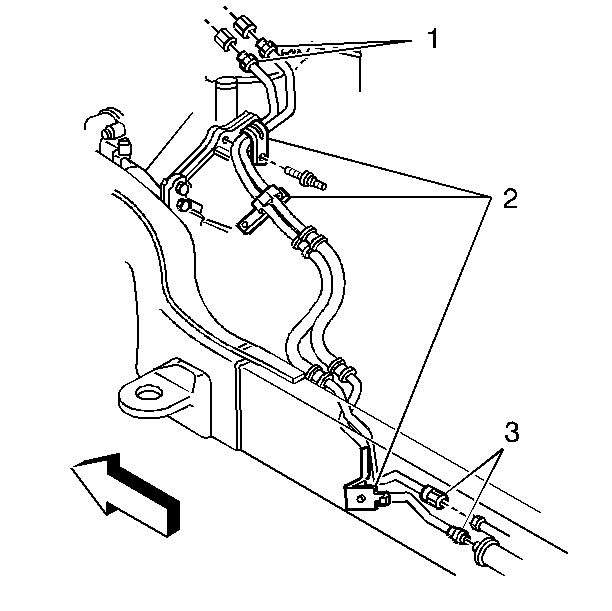Fuel Hose/Pipes Assembly Replacement Filter to Tank
Removal Procedure
- Disconnect the negative battery cable.
- Relieve the fuel system pressure. Refer to Fuel Pressure Relief .
- Clean all the fuel pipe connections and the surrounding areas before disconnecting the pipes in order to avoid possible contamination of the fuel system.
- Drain the fuel tank. Refer to Fuel Tank Draining .
- Raise the vehicle. Refer to Lifting and Jacking the Vehicle in General Information.
- Disconnect the fuel feed and return pipe fittings at the fuel filter and the return pipe union (3).
- Remove the fuel tank. Refer to Fuel Tank Replacement .
- Remove the fuel feed and return pipes from the retaining clips (2).
Caution: Unless directed otherwise, the ignition and start switch must be in the OFF or LOCK position, and all electrical loads must be OFF before servicing any electrical component. Disconnect the negative battery cable to prevent an electrical spark should a tool or equipment come in contact with an exposed electrical terminal. Failure to follow these precautions may result in personal injury and/or damage to the vehicle or its components.
Caution: To avoid any vehicle damage, serious personal injury or death when major components are removed from the vehicle and the vehicle is supported by a hoist, support the vehicle with jack stands at the opposite end from which the components are being removed and strap the vehicle to the hoist.


Installation Procedure
- Install the fuel feed and return pipes into the retaining clips (2).
- Install the fuel tank. Refer to Fuel Tank Replacement .
- Connect the fuel feed and return pipes (3) to the fuel filter and the return pipe union.
- Lower the vehicle.
- Refill the fuel system.
- Tighten the fuel filler cap.
- Connect the negative battery cable.
- Inspect for fuel leaks.


Notice: Use the correct fastener in the correct location. Replacement fasteners must be the correct part number for that application. Fasteners requiring replacement or fasteners requiring the use of thread locking compound or sealant are identified in the service procedure. Do not use paints, lubricants, or corrosion inhibitors on fasteners or fastener joint surfaces unless specified. These coatings affect fastener torque and joint clamping force and may damage the fastener. Use the correct tightening sequence and specifications when installing fasteners in order to avoid damage to parts and systems.
Tighten
Tighten the fuel pipe fittings to 27 N·m (20 lb ft)
using a back-up wrench.
| 8.1. | Turn ON the ignition for 2 seconds. |
| 8.2. | Turn OFF the ignition for 10 seconds. |
| 8.3. | Turn ON the ignition. |
| 8.4. | Inspect for fuel leaks. |
Fuel Hose/Pipes Assembly Replacement Fuel Pipe Repair
Steel fuel pipes -- These are welded steel tubes, meeting GM specifications 124-M, or its equivalent. The fuel feed pipe is 3/8 inches diameter and the fuel return pipe is 5/16 inches diameter. Do not use copper or aluminum tubing to replace steel tubing. Those materials do not have satisfactory durability to withstand normal vehicle vibration.
Coupled hose -- Do not repair the hoses. Replace them only as an assembly.
Uncoupled hose -- Use only reinforced fuel resistant hose, made of Fluoroelastomer material. Do not use a hose within 4 inches (100 mm) of any part of the exhaust system, or within 10 inches (2154 mm) of the catalytic converter. The hoses inside diameter must match the outside diameter of the steel tubing.
Clamps -- These are stainless steel, screw bank-type clamps, #2494772, or equivalent.
Steel Fuel Pipe Repair
- Cut a piece of fuel hose 4 inches (100 mm) longer than the section of pipe to be removed. If you remove more than 6 inches (152 mm), use a combination of steel pipe and hose. The hose length should not be more than 10 inches total.
- With a tube cutter, cut a section of the pipe to replace. Use the first step on the reamer to form a bead on the ends of the pipe and on the new section of pipe, if used.
- Slide the hose clamps onto the pipe and push the hose 2 inches (51 mm) onto each portion of the fuel pipe. Tighten a clamp on each side of the repair.
- Secure fuel pipe to the frame.
- Inspect for leaks.
| 5.1. | Turn ON the ignition for 2 seconds. |
| 5.2. | Turn OFF the ignition for 10 seconds. |
| 5.3. | Turn ON the ignition. |
| 5.4. | Inspect for fuel leaks. |
